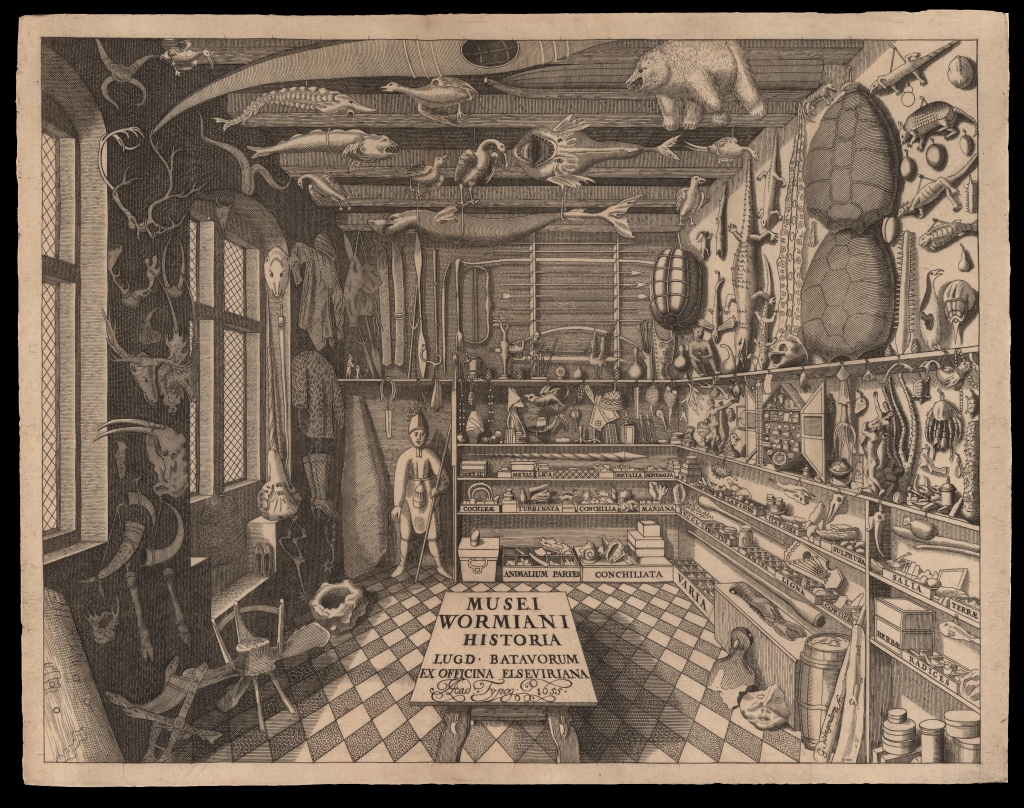
Now that we’ve dealt with the role of animals in literature, I’d now like to invite you to study their scientific role. Aside from relying on animals for didactic purposes, scholars have also relied on animals as a means of observation – particularly in terms of their physical features and behaviors. Placed within an environment of study, these animals are labelled “specimens”.
I assure you that we aren’t going to dissect some poor frog, nor are we going to experiment on an innocent lab rat. Instead, we’re going to study these specimens through a more humane lens – particularly in terms of art pieces that include these subjects.

The image above depicts an engraving created by Danish historian Ole Worm (1588 – 1654) in 1655. Worm is described by scholars as an antiquarian – a person who studies or collects antiques or antiquities. According to the engraving’s entry at the John Carter Brown Library, the Musei Wormiani Historia is a depiction of Worm’s own museum in Copenhagen, where he would display his collection of various specimens. Some of these collectibles include bones, aquatic shells, and even animal taxidermy pieces. For the rest of this blog post, I’d like to point your attention to additional details within the engraving.
When I first look at this piece, the details I immediately pick up on are the perspective lines that stop at the room’s farthest wall. This gives the engraving a three-dimensional feel to it, almost as if we can “step” into the setting and walk forward. To add, this perspective facilitates the studying of these specimens, as we are given a clear view of them adorned along all four walls. As our eyes are beckoned to move deeper into the room, our wonder heightens as we come to observe and admire the specimens that surround us.


After being encouraged to dive in and explore, I notice that Worm has kept his smaller specimens closer to the museum floor, while larger ones are closer to the ceiling. For instance, the image to the right depicts Worm’s collection of sea shells, animal bones, and minerals, all of which are organized and classified into distinctly-labelled boxes. Meanwhile, as shown in the image on the left, bigger pieces like the pair of tortoise shells and the strip of snake skin are hung up against the upper walls. By doing so, Worm seemingly builds suspense among his viewers as they gradually move their attention from the smaller, delicate specimens to larger ones. Returning to the idea of wonder, this sense reaches its peak once we begin to study these larger specimens, as these are now less accessible than the ones below and thus can’t be as closely observed.

Finally, look closely at this image on the right – it’s zooming in on the farthest wall in the engraving. Worm’s inclusion of these weapons, which the JCB Library identifies as bows and arrows, seems somewhat unusual, given that his museum is mostly filled with animal specimens. While viewers may seem uncomfortable with these weapons (since it is unknown whether these animal specimens died of natural causes or violent means), they nonetheless raise an interesting notion. Because these are human tools, we are left to wonder whether this was Worm’s attempt at including human-related specimens within his engraving. In doing so, Worm has his viewers identify something familiar to them, and thus make them feel a sense of connection to the setting. While this seems to clash with the engraving’s use of mostly animal specimens, I suggest otherwise. After all, humans are biologically considered animals, so they fit with the engraving’s naturalistic theme. However, because labelling humans as specimens is somewhat dehumanizing, Worm may have chosen these tools as a “neutral” source – both to nod back to humans but to also add variety to the setting and amplify the viewer’s wonder.
If you take just a few minutes to closely observe Musei Wormiani Historia, I assure you you’ll find dozens of similar details like the ones I’ve described here. If you found this subject interesting, I recommend you to study Insects and Fruit by Flemish artist Jan Van Kessel (1626 – 1679) and The Entry of the Animals into Noah’s Ark by Flemish artist Jan Breughel the Elder (1568 – 1625). Such paintings offer the wonderful advantage of studying these specimens humanely, so I hope you’ll take the time to further research and appreciate this artistic genre.
Works Cited:
“Ole Worm.” Wikipedia, Wikimedia Foundation, 25 Dec. 2019, https://en.wikipedia.org/wiki/Ole_Worm.
“Musei Wormiani Historia.” Musei Wormiani Historia – JCB Archive of Early American Images, https://jcb.lunaimaging.com/luna/servlet/detail/JCB~1~1~4009~6190007:Musei-Wormiani-historia.